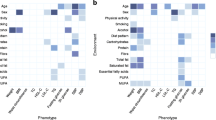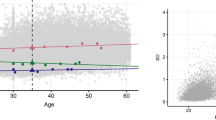Abstract
Heritability measures the proportion of phenotypic variation attributable to genetic factors. In addition to a shared nuclear genetic component, a number of additional variance components, such as spousal correlation, sibship, household and maternal effects, may have strong contributions to inter-individual phenotype variation. In humans, the confounding effects of these components on heritability have not been studied thoroughly. We sought to obtain unbiased heritability estimates for complex traits in the presence of multiple variance components and also to estimate the contributions of these variance components to complex traits. We compared regression and variance component methods to estimate heritability in simulations when additional variance components existed. We then revisited heritability for several traits in Framingham Heart Study (FHS) participants. Using simulations, we found that failure to account for or misclassification of necessary variance components yielded biased heritability estimates. The direction and magnitude of the bias varied depending on a variance structure and an estimation method. Using the best fitted models to account for necessary variance components, we found that heritability estimates for most FHS traits were overestimated, ranging from 4 to 47 %, when we compared models that considered necessary variance components to models that only considered familial relationships. Spousal correlation explained 14–36 % of phenotypic variation in several anthropometric and lifestyle traits. Maternal and sibling effects also contributed to phenotypic variation, ranging from 3 to 5 % and 4 to 7 %, respectively, in several anthropometric and metabolic traits. Our findings may explain, in part, the missing heritability for some traits.
Similar content being viewed by others
References
Abecasis GR, Cardon LR, Cookson WO, Sham PC, Cherny SS (2001) Association analysis in a variance components framework. Genet Epidemiol 21(Suppl 1):S341–S346
Amos CI (1994) Robust variance-components approach for assessing genetic linkage in pedigrees. Am J Hum Genet 54:535–543
Burggren WW, Crews D (2014) Epigenetics in comparative biology: why we should pay attention. Integr Comp Biol 54:7–20
Dawber TR, Meadors GF, Moore FE Jr (1951) Epidemiological approaches to heart disease: the Framingham Study. Am J Public Health Nations Health 41:279–281
Feinleib M, Kannel WB, Garrison RJ, McNamara PM, Castelli WP (1975) The Framingham Offspring Study. Design and preliminary data. Prev Med 4:518–525
Hill WG, Goddard ME, Visscher PM (2008) Data and theory point to mainly additive genetic variance for complex traits. PLoS Genet 4:e1000008
Holt IJ, Harding AE, Morgan-Hughes JA (1988) Deletions of muscle mitochondrial DNA in patients with mitochondrial myopathies. Nature 331:717–719
Kannel WB, Feinleib M, McNamara PM, Garrison RJ, Castelli WP (1979) An investigation of coronary heart disease in families. The Framingham offspring study. Am J Epidemiol 110:281–290
Keller MC, Medland SE, Duncan LE (2010) Are extended twin family designs worth the trouble? A comparison of the bias, precision, and accuracy of parameters estimated in four twin family models. Behav Genet 40:377–393
Keverne EB (2013) Importance of the matriline for genomic imprinting, brain development and behaviour. Philos Trans R Soc Lond B Biol Sci 368:20110327
Knuiman MW, Divitini ML, Bartholomew HC, Welborn TA (1996) Spouse correlations in cardiovascular risk factors and the effect of marriage duration. Am J Epidemiol 143:48–53
Li R, Liu Y, Li Z, Yang L, Wang S, Guan MX (2009) Failures in mitochondrial tRNAMet and tRNAGln metabolism caused by the novel 4401A>G mutation are involved in essential hypertension in a Han Chinese Family. Hypertension 54:329–337
Liu Y, Li R, Li Z, Wang XJ, Yang L, Wang S, Guan MX (2009) Mitochondrial transfer RNAMet 4435A>G mutation is associated with maternally inherited hypertension in a Chinese pedigree. Hypertension 53:1083–1090
Liu C, Yang Q, Hwang SJ, Sun F, Johnson AD, Shirihai OS, Vasan RS, Levy D, Schwartz F (2012) Association of genetic variation in the mitochondrial genome with blood pressure and metabolic traits. Hypertension 60:949–956
Liu C, Dupuis J, Larson MG, Levy D (2013) Association testing of the mitochondrial genome using pedigree data. Genet Epidemiol 37:239–247
Lynch M, Walsh B (1998) Genetics and analysis of quantitative traits. Sinauer Associates, Incorporated
Maniatis N, Pollott GE (2002) Nuclear, cytoplasmic, and environmental effects on growth, fat, and muscle traits in suffolk lambs from a sire referencing scheme. J Anim Sci 80:57–67
Morton NE (1974) Analysis of family resemblance. I. Introduction. Am J Hum Genet 26:318–330
Morton NE, MacLean CJ (1974) Analysis of family resemblance. 3. Complex segregation of quantitative traits. Am J Hum Genet 26:489–503
Relton CL, Groom A, St Pourcain B, Sayers AE, Swan DC, Embleton ND, Pearce MS, Ring SM, Northstone K, Tobias JH, Trakalo J, Ness AR, Shaheen SO, Davey Smith G (2012) DNA methylation patterns in cord blood DNA and body size in childhood. PLoS One 7:e31821
Schork NJ, Guo SW (1993) Pedigree models for complex human traits involving the mitochondrial genome. Am J Hum Genet 53:1320–1337
Splansky GL, Corey D, Yang Q, Atwood LD, Cupples LA, Benjamin EJ, D’Agostino RB Sr, Fox CS, Larson MG, Murabito JM, O’Donnell CJ, Vasan RS, Wolf PA, Levy D (2007) The Third Generation Cohort of the National Heart, Lung, and Blood Institute’s Framingham Heart Study: design, recruitment, and initial examination. Am J Epidemiol 165:1328–1335
Sun F, Cui J, Gavras H, Schwartz F (2003) A novel class of tests for the detection of mitochondrial DNA-mutation involvement in diseases. Am J Hum Genet 72:1515–1526
Taylor RW, Turnbull DM (2005) Mitochondrial DNA mutations in human disease. Nat Rev Genet 6:389–402
Tenesa A, Haley CS (2013) The heritability of human disease: estimation, uses and abuses. Nat Rev Genet 14:139–149
Venkatraman A, He XC, Thorvaldsen JL, Sugimura R, Perry JM, Tao F, Zhao M, Christenson MK, Sanchez R, Yu JY, Peng L, Haug JS, Paulson A, Li H, Zhong XB, Clemens TL, Bartolomei MS, Li L (2013) Maternal imprinting at the H19-Igf2 locus maintains adult haematopoietic stem cell quiescence. Nature 500:345–349
Visscher PM (2006) A note on the asymptotic distribution of likelihood ratio tests to test variance components. Twin Res Hum Genet 9:490–495
Visscher PM, Hill WG, Wray NR (2008) Heritability in the genomics era—concepts and misconceptions. Nat Rev Genet 9:255–266
Voet D, Voet J, Pratt C (2013) Fundamentals of biochemistry: life at the molecular level, 4th edn. Wiley, USA
Wallace DC (1992) Mitochondrial genetics: a paradigm for aging and degenerative diseases? Science 256:628–632
Wallace DC, Singh G, Lott MT, Hodge JA, Schurr TG, Lezza AM, Elsas LJ 2nd, Nikoskelainen EK (1988) Mitochondrial DNA mutation associated with Leber’s hereditary optic neuropathy. Science 242:1427–1430
Wang S, Li R, Fettermann A, Li Z, Qian Y, Liu Y, Wang X, Zhou A, Mo JQ, Yang L, Jiang P, Taschner A, Rossmanith W, Guan MX (2011) Maternally inherited essential hypertension is associated with the novel 4263A>G mutation in the mitochondrial tRNAIle gene in a large Han Chinese family. Circ Res 108:862–870
Willmore KE, Leamy L, Hallgrimsson B (2006) Effects of developmental and functional interactions on mouse cranial variability through late ontogeny. Evol Dev 8:550–567
Wilson FH, Hariri A, Farhi A, Zhao H, Petersen KF, Toka HR, Nelson-Williams C, Raja KM, Kashgarian M, Shulman GI, Scheinman SJ, Lifton RP (2004) A cluster of metabolic defects caused by mutation in a mitochondrial tRNA. Science 306:1190–1194
Wolf JB, Wade MJ (2009) What are maternal effects (and what are they not)? Philos Trans R Soc Lond B Biol Sci 364:1107–1115
Wong AH, Gottesman II, Petronis A (2005) Phenotypic differences in genetically identical organisms: the epigenetic perspective. Hum Mol Genet 14(Spec No 1):R11–18
Xiang AH, Azen SP, Buchanan TA, Raffel LJ, Tan S, Cheng LS, Diaz J, Toscano E, Quinonnes M, Liu CR, Liu CH, Castellani LW, Hsueh WA, Rotter JI, Hodis HN (2002) Heritability of subclinical atherosclerosis in Latino families ascertained through a hypertensive parent. Arterioscler Thromb Vasc Biol 22:843–848
Xing J, Chen M, Wood CG, Lin J, Spitz MR, Ma J, Amos CI, Shields PG, Benowitz NL, Gu J, de Andrade M, Swan GE, Wu X (2008) Mitochondrial DNA content: its genetic heritability and association with renal cell carcinoma. J Natl Cancer Inst 100:1104–1112
Yang Q, Kim SK, Sun F, Cui J, Larson MG, Vasan RS, Levy D, Schwartz F (2007) Maternal influence on blood pressure suggests involvement of mitochondrial DNA in the pathogenesis of hypertension: the Framingham Heart Study. J Hypertens 25:2067–2073
Yang J, Benyamin B, McEvoy BP, Gordon S, Henders AK, Nyholt DR, Madden PA, Heath AC, Martin NG, Montgomery GW, Goddard ME, Visscher PM (2010) Common SNPs explain a large proportion of the heritability for human height. Nat Genet 42:565–569
Zuk O, Hechter E, Sunyaev SR, Lander ES (2012) The mystery of missing heritability: genetic interactions create phantom heritability. Proc Natl Acad Sci USA 109:1193–1198
Acknowledgments
We acknowledge support from NHLBI, Framingham Heart Study, (NHLBI/NIH Contract #N01-HC-25195), from NIH NIDDK R01 DK078616 and K24 DK080140, from the Boston University School of Medicine, and from contracts 53-K06-5-10 and 58-1950-9-001 from the US Department of Agriculture, Agriculture Research Service. We thank Dr. Qiong Yang of Biostatistics, School of Public Health at Boston University for helpful discussions and Dr. Kathryn Lunetta of Biostatistics, School of Public Health at Boston University for providing R codes for incorporating additional variance components in lmekin () function.
Author information
Authors and Affiliations
Corresponding author
Electronic supplementary material
Below is the link to the electronic supplementary material.
Rights and permissions
About this article
Cite this article
Liu, C., Dupuis, J., Larson, M.G. et al. Revisiting heritability accounting for shared environmental effects and maternal inheritance. Hum Genet 134, 169–179 (2015). https://doi.org/10.1007/s00439-014-1505-6
Received:
Accepted:
Published:
Issue Date:
DOI: https://doi.org/10.1007/s00439-014-1505-6




